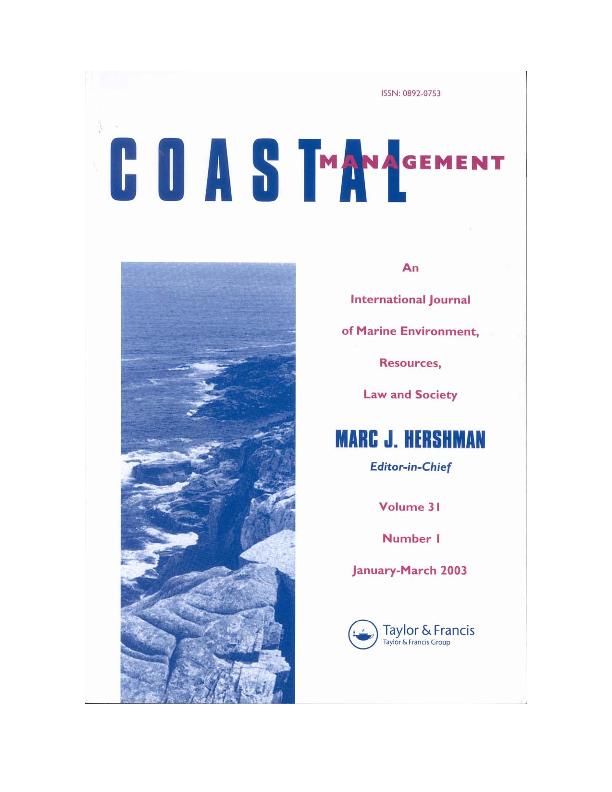Artículo
Preliminary Basis for an Integrated Management Program for the Coastal Zone of Argentina
Barragán Munoz, Juan M.; Dadon, Jose Roberto ; Matteucci, Silvia Diana
; Matteucci, Silvia Diana ; Morello, Jorge Helios
; Morello, Jorge Helios ; Baxendale, Claudia Alicia; Rodríguez, Andrea
; Baxendale, Claudia Alicia; Rodríguez, Andrea
 ; Matteucci, Silvia Diana
; Matteucci, Silvia Diana ; Morello, Jorge Helios
; Morello, Jorge Helios ; Baxendale, Claudia Alicia; Rodríguez, Andrea
; Baxendale, Claudia Alicia; Rodríguez, Andrea
Fecha de publicación:
03/2003
Editorial:
Taylor & Francis
Revista:
Coastal Management
ISSN:
0892-0753
e-ISSN:
1521-0421
Idioma:
Inglés
Tipo de recurso:
Artículo publicado
Clasificación temática:
Resumen
The continental coastal zone of Argentina can be differentiated by environmental, biological, socioeconomic, and historical characteristics in four distinct regions. The Great Fluvial region, 3725 km long, shows richness of natural resources and has a developing economy based on forestry and agriculture, The La Plata River (Río de la Plata) region, with a 392 km waterfront, is the most densely populated, urbanized, industrialized area in the country, and it also exhibits high levels of environmental degradation. The Pampean (Pampeana) and the Patagonian (Patagónica) regions have a 4725 km litoral They hold important fishery stocks, the largest of which (the hake) is currently overexploited. Tourism demand has caused urban landscape to progress in the Pampa coast during the last three decades. In Patagonia, most of the natural resources are well preserved but the territorial and economic integration is still delayed. Despite the environmental and socioeconomic differences among the four regions, there is, however, a common set of problems which, to a greater or lesser extent, affect them all: (a) privatization of the public domain; (b) inadequate urban planning of the coastal zone; (c) industrial and urban pollution; (d) coastal erosion linked to inadequate coastal management practices; (e) overexploitation of natural resources; (f) loss and fragmentation of natural habitats leading to the loss of biodiversity; (g) increased coastal vulnerability. According to this diagnosis, coordinated specific, long-term actions should be promoted. Even when Argentina has a wide range of environmental legislation, it lacks a single tool or instrument specifically designed for coastal management. Most of the regulations and administrative requirements applied to the current coastal zone management are general normatives, and thus diffuse or hardly suitable for specific situations. We propose to attain consensus about a minimal preliminary basis in order to develop a national integrated management coastal program. Some of the issues are: design of specific governmental policies; creation of a specific institutional organization; long-term funding for the program; promotion of inter-institutional coordination and public participation in the decision-making process; development of specific research, education, training and information generation; and promotion of international cooperation aimed at sharing experiences in coastal zone management.
Palabras clave:
ARGENTINA
,
ICZM
,
LA PLATA RIVER BASIN
,
PAMPA
,
PATAGONIA
Archivos asociados
Licencia
Identificadores
Colecciones
Articulos(OCA CIUDAD UNIVERSITARIA)
Articulos de OFICINA DE COORDINACION ADMINISTRATIVA CIUDAD UNIVERSITARIA
Articulos de OFICINA DE COORDINACION ADMINISTRATIVA CIUDAD UNIVERSITARIA
Articulos(SEDE CENTRAL)
Articulos de SEDE CENTRAL
Articulos de SEDE CENTRAL
Citación
Barragán Munoz, Juan M.; Dadon, Jose Roberto; Matteucci, Silvia Diana; Morello, Jorge Helios; Baxendale, Claudia Alicia; et al.; Preliminary Basis for an Integrated Management Program for the Coastal Zone of Argentina; Taylor & Francis; Coastal Management; 31; 1; 3-2003; 55-77
Compartir
Altmétricas



